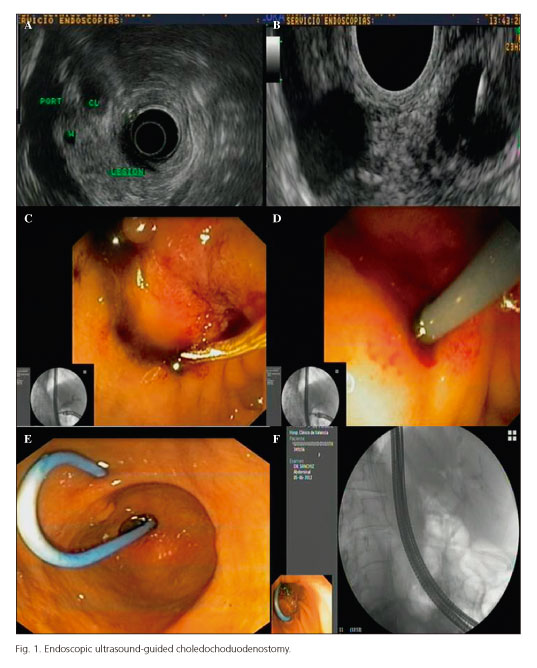Mi SciELO
Servicios Personalizados
Revista
Articulo
Indicadores
-
 Citado por SciELO
Citado por SciELO -
 Accesos
Accesos
Links relacionados
-
 Citado por Google
Citado por Google -
 Similares en
SciELO
Similares en
SciELO -
 Similares en Google
Similares en Google
Compartir
Revista Española de Enfermedades Digestivas
versión impresa ISSN 1130-0108
Rev. esp. enferm. dig. vol.106 no.6 Madrid jun. 2014
LETTERS TO THE EDITOR
Endoscopic ultrasound-guided choledochoduodenostomy: A propos of two cases
Coledocoduodenostomía guiada por ultrasonido endoscópico: a propósito de dos casos
Key words: Biliary tract. EUS-guided drainage. Endoscopic ultrasound.
Palabras clave: Vía biliar. Drenaje endoscópico. Ecoendoscopia.
Dear Editor,
EUS-guided biliary drainage is a tool described by Giovannini in 2001 for the treatment of obstructive lesions in the biliary tract. Choledochoduodenostomy under EUS is a feasible approach with low morbidity and mortality for the management of jaundice secondary to distal obstruction (distal biliary, head of the pancreas, or major papilla tumors). Two cases are reported of patients with bile duct obstruction of malignant etiology who underwent EUS-guided drainage following a failed ERCP.
Case reports
Two cases are reported of two patients -70 and 71 years of age- with biliary obstruction secondary to adenocarcinoma of the papilla and adenocarcinoma of the head of the pancreas, respectively, in both cases following a failed ERCP procedure because of tumor infiltration. We proceeded to perform a transmural biliary drainage procedure under EUS guidance (Fig. 1A). The duodenal bulb was entered, where a distally dilated choledochus was identified proximal to the tumor; it was punctured with a 19A gauge needle (Fig. 1B), which confirmed ductal access with bile release; then a contrast medium was injected and a guidewire was passed (Fig. 1C); a 4-mm Hurricane on the wire was used to dilate the duodenocholedochal tract (Fig. 1D), and a 10-Fr biliary pig-tail stent was placed (Fig. 1E), in both cases witnessing contrast voiding (Fig. 1F) and the pouring out of abundant biliary fluid. Biliary tract drainage was satisfactorily successful in both patients using the EUS-guided choledochoduodenostomy technique. Prior to the procedure, patient 1 had a total bilirubin of 16.52 mg/dl, and at day 22 following drainage total bilirubin was 6.41 mg/dl. Patient 2 had a total bilirubin of 19.95 mg/dl and then of 4.19 mg/dl at day 15 after drainage. No immediate complications were reported and a definitive surgical therapy could be performed.
Discussion
Although current data are limited, transmural biliary drainage under the guidance of endoscopic ultrasounds represents a huge potential as an alternative for biliary drainage following a failed ERCP. It is a complex, invasive procedure that requires appropriate patient selection and shows favorable outcomes with a low morbidity and mortality.
Vicente Sanchiz, Oswaldo R. Moreno, Luis E. Barreda,
María Mora, Pablo R. Navarro, Andrés Peña and Francisco Mora
Department of Digestive Medicine. Hospital Clínico Universitario de Valencia.
Universidad de Valencia. Valencia, Spain
References
1. Artifon ELA, Ferreira FC, Otoch JP. Coledocoduodenostomía guiada por ultrasonido endoscópico para la paliación de la obstrucción biliar distal maligna. Revista de gastroenterología de Mexico 2012;77:31-7. [ Links ]
2. Giovannini M, Moutardier V, Pesenti C, Bories E, Lelong B, Delpero JR. Endoscopic ultrasound-guided bilioduodenal anastomosis: A new technique for biliary drenage. Endoscopy 2001;33:898-900. [ Links ]
3. Itoi T, Itokawa F, Tsuchiya T, Tsuji S, Tonozuka R. Endoscopic ultrasound-guided choledochoantrostomy as an alternative extrahepatic bile duct drainage method in pancreatic cancer with duodenal invasion. Dig Endosc 2013;25(Supl. 2):142-5. [ Links ]
4. Kim TH, Kim SH, Oh HJ, Sohn YW, Lee SO. Endoscopic ultrasound-guided biliary drainage with placement of a fully covered metal stent for malignant biliary obstruction. World J Gastroenterol 2012;18:2526-32. [ Links ]











 texto en
texto en 



